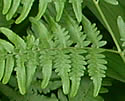Pteridium aquilinum (Bracken)
| Also known as: | Western Bracken Fern |
|---|---|
| Genus: | Pteridium |
| Family: | Dennstaedtiaceae (Bracken Fern) |
| Life cycle: | perennial |
| Origin: | native |
| Habitat: | part shade, sun; poor or sandy soil; upland woods, woodland edges |
| Fruiting season: | summer |
| Plant height: | 1 to 3 feet |
| Wetland Indicator Status: | GP: FACU MW: FACU NCNE: FACU |
| MN county distribution (click map to enlarge): |  |
| National distribution (click map to enlarge): |  |
Pick an image for a larger view. See the glossary for icon descriptions.
Detailed Information
Fiddlehead:
![[photo of fiddlehead]](/udata/r9ndp23q/ferns/bracken-fern_0408_151133-t.jpg) Fiddleheads emerge in early spring, brown stems covered in silvery gray hair. Even before the leaves unfurl, the division of the stem into 3 parts is apparent.
Fiddleheads emerge in early spring, brown stems covered in silvery gray hair. Even before the leaves unfurl, the division of the stem into 3 parts is apparent.
Leaves and stems: 

![[photo of fronds]](/udata/r9ndp23q/ferns/bracken-fern_0504_153228-t.jpg) At the top of the stem is a whorl of 3 leaves (fronds), each 2 or 3 times compound and generally triangular in outline. The leaf blade is 2 to 4 feet long and 1 to 3 feet wide. The leaves are held nearly erect to almost horizontal, parallel to the ground.
At the top of the stem is a whorl of 3 leaves (fronds), each 2 or 3 times compound and generally triangular in outline. The leaf blade is 2 to 4 feet long and 1 to 3 feet wide. The leaves are held nearly erect to almost horizontal, parallel to the ground.
![[photo of leaflet underside]](/udata/r9ndp23q/ferns/bracken-fern_0504_153006-t.jpg) The shape of the leaflets varies, with 10 to 12 pair of deeply lobed segments that are oblong to narrowly triangular; segments may be further lobed. Veins are forked. Leaf and leaflet stalks (rachis) are green but turn dark brown later in the season, are slightly grooved, and may have miniscule rough hairs. The main stem (stipe) is brown near the base and covered in short hairs
The shape of the leaflets varies, with 10 to 12 pair of deeply lobed segments that are oblong to narrowly triangular; segments may be further lobed. Veins are forked. Leaf and leaflet stalks (rachis) are green but turn dark brown later in the season, are slightly grooved, and may have miniscule rough hairs. The main stem (stipe) is brown near the base and covered in short hairs
Spores: 
![[photo of spores]](/udata/r9ndp23q/ferns/bracken-fern_0617_140525-t.jpg) Spores develop in mid to late June on the underside of the leaves in a continuous narrow band along the leaf edge, though the rolled edges may cover them. Spores may persist through late summer. There is no significant difference between fertile and sterile fronds.
Spores develop in mid to late June on the underside of the leaves in a continuous narrow band along the leaf edge, though the rolled edges may cover them. Spores may persist through late summer. There is no significant difference between fertile and sterile fronds.
Notes:
Bracken fern is very common and tends to form large colonies through underground rhizomes. It is easy to identify as it is a relatively large fern with 3 broadly triangular compound leaves, often held horizontally, at the top of a long stem. While the Oak ferns (Gymnocarpium species) also have triangular compound leaves held horizontally, they are much smaller plants, under 16 inches tall, and have round sori (spore clusters) at vein tips. Bracken releases allelopathic chemicals that inhibit the growth of other plants and contains other toxins that are poisonous to many animals. It is the first plant to be killed by frost but will resprout quickly after a fire and can be weedy. An abundance of Bracken is usually indicative of a degraded habitat. There are 4 varieties of Bracken in North America, with var. latiusculum found in Minnesota.
Native Plant Nurseries, Restoration and Landscaping Services ↓
More photos
Photos by K. Chayka taken in Ramsey County. Photos courtesy Peter M. Dziuk taken in Anoka County.
Comments
Have you seen this plant in Minnesota, or have any other comments about it?
on: 2019-04-25 13:00:48
Is this type of native bracken that can also be used as a dye? Some brackens will make a yellow dye.
on: 2019-06-04 07:00:16
Many of these growing in the area, including my yard.
on: 2019-06-25 13:51:20
I have two types of ferns in our very large woods. North of St. Cloud. The bracken are distinct amongst the other type we have in abundance. Growing amidst our wild raspberries.
on: 2019-07-28 08:24:22
We took the High Falls walking trail July, 2019. Many beautiful native plants along the trail. My favorite was this tall flat fern. Happy to find the name on this website, Bracken Fern. Hope to be able to find a plant to buy and add to my shady tree garden. Thank you for this website.
on: 2020-04-20 10:14:48
Abundant here. On a walk through the woods, it offers a handy swisher against deer flies, gnats etc.; doesn't break apart like ostrich fern or scratch your face like spruce or maple.
on: 2021-07-02 18:51:51
At the point where the frond splits into three are small glands that secrete a sugary solution. These are visited by ants in the early spring.
on: 2021-08-02 13:54:48
This grows along many trails, coexisting with ladyslippers, poison ivy, wild blackberries, red & white baneberries, marsh marigolds, Solomon?s seal, various sedges, and native roses. It grows everywhere, from shady, wet marshes to hot, dry, rocky, south and west facing hillsides. Many of the native plants growing near it seem relatively resistant to the allelopathic chemicals, though some are definitely sensitive to it.







 Bracken Fern plant
Bracken Fern plant view from top of plant
view from top of plant upper side of leaflet
upper side of leaflet